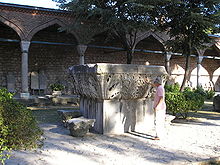Medieval Greek: Πιττάκια | |
 | |
Location in Constantinople | |
| Location | Forum of Leo, Constantinople Topkapı Palace, Fatih, Istanbul, Turkey |
|---|---|
| Coordinates | 41°00′48″N 28°59′05″E / 41.013276°N 28.984825°E |
| Type | Roman triumphal column |
| Diameter | c. 2.10 m (column drums) c. 3m (capital) |
| Height | c. 21-26 m (total original without statue)
20.75 m (column shaft) 6 m (granite socle) |
| History | |
| Builder | Euphemia or Verina augusta |
| Material | marble |
| Founded | 457-474 AD (reign of Leo I) |
| Periods | Late Antiquity |
| Cultures | East Roman Empire |
| Site notes | |
| Archaeologists | Aziz Oğan |
| Condition | Ruined |
| Architecture | |
| Architectural styles | Corinthian |
| Architectural details | Roman |
The Column of Leo was a 5th-century AD Roman honorific column in Constantinople. Built for Leo I, Augustus of the East from 7 February 457 to 18 January 474,[1] the column stood in the Forum of Leo, known also as the Pittakia. It was a marble column, without flutes, composed of drums with a Corinthian capital, surmounted by a statue of the emperor.[2]
The column no longer exists, but fragments belonging to it were discovered in the mid-20th century in the grounds of the Topkapı Palace, including the capital and the impost block atop it, a complete column drum and some parts of a second, and the statue's pedestal, which was originally separated from the impost by a missing plinth. The remains are visible in the second courtyard of the Topkapı complex.[3] The column's own socle, pedestal, and base are lost. The statue too may be lost, or it may be the bronze statue now known as the Colossus of Barletta in Italy.[2]
- ^ Martindale, John R., ed. (1980). "Leo 6". The Prosopography of the Later Roman Empire: Volume II, AD 395–527. Cambridge: Cambridge University Press. ISBN 0-521-20159-4.
- ^ a b Gehn, Ulrich (2012). "LSA-2462 Remains of column, once crowned with colossal statue, almost certainly of Leo I, emperor. Constantinople, Forum of Leo I ('Pittakia'). 457-474". laststatues.classics.ox.ac.uk. Retrieved 2020-03-07.
- ^ Dark, K. R.; Harris, A. L. (2008-03-26). "The Last Roman Forum: the Forum of Leo in Fifth-century Constantinople". Greek, Roman, and Byzantine Studies. 48 (1): 57–69. ISSN 2159-3159.

